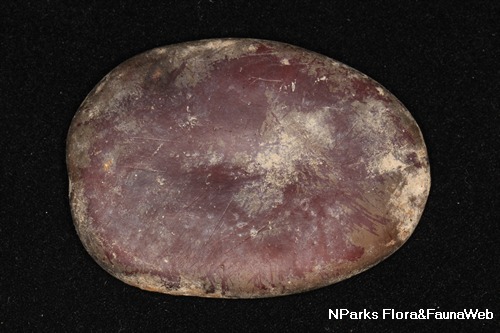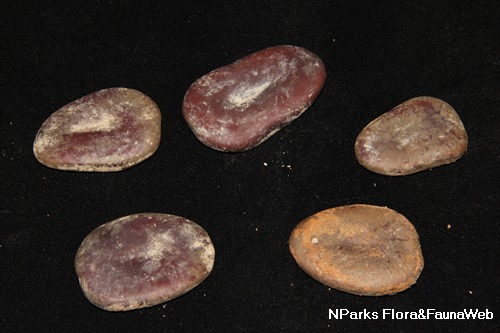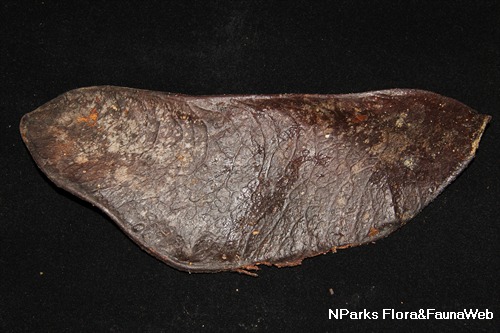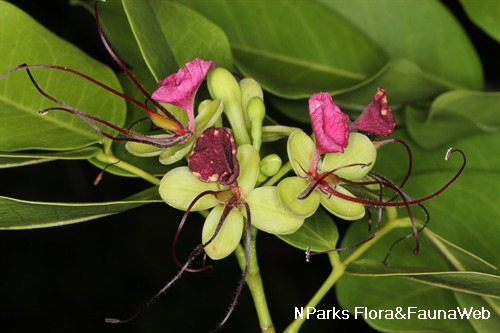
Back
Intsia palembanica Miq.
| Family Name: | Fabaceae (Leguminosae) |
| Common Name: | Merbau, Malacca Teak, Borneo Teak |
Name
Classifications and Characteristics
| Plant Division | Angiosperms (Flowering Seed Plants) (Dicotyledon) |
|---|---|
| Plant Growth Form | Tree (Big (>30m)) |
| Lifespan (in Singapore) | Perennial |
| Mode of Nutrition | Autotrophic |
| Plant Shape | Irregular |
| Maximum Height | 50 m |
Biogeography
| Native Distribution | India, Thailand, Sumatra, Malaysia, Singapore, and Borneo |
|---|---|
| Native Habitat | Terrestrial (Primary Rainforest, Secondary Rainforest, Coastal Forest) |
| Preferred Climate Zone | Tropical, Sub-Tropical / Monsoonal |
| Local Conservation Status | Native to Singapore (Critically Endangered (CR)) |
Description and Ethnobotany
| Growth Form | It is a tree up to 50 m tall, with pinkish-grey bark that is shallowly marked with small, thin, roundish scaling pieces. |
|---|---|
| Roots | Its buttresses, when present, can be up to 4 m tall. |
| Foliage | Its alternate, stalked, pinnate leaves usually have 4 pairs of opposite leaflets. Its leaflets have thickly leathery blades that are usually egg-shaped or oval and 3–19 by 3–11 cm. The blade tips are sometimes slightly notched. |
| Flowers | Its flowering shoot is up to 10 cm long, with pale yellowish flowers. |
| Fruit | Its smooth fruits are brown or black when ripe, 15–40 by 5.5–9 cm, and contain several seeds. Its flat seeds are thick and 3–4.5 by 1.5–3 cm. |
| Habitat | It grows in coastal regions, and inland lowland forests, up to 850 m altitude. It occurs locally in Bukit Timah Nature Reserve. |
| Associated Fauna | Its flowers are insect-pollinated. It is also the preferred local food plant for caterpillars of the moth, Cossus chloratus. |
| Cultivation | It can be propagated by seed. |
| Etymology | Latin intsia, from the Indian name for Acacia intsia; Latin palembanica, from Palembang, Sumatra, referring to one locality in the natural distribution of this species |
| Ethnobotanical Uses | Edible Plant Parts : Edible Seeds Food (Fruit or Vegetable): The young seeds are edible. Medicinal: The bark and leaves are used medicinally. Timber & Products: The wood is the main source of the commercial timber known as merbau. Others: The wood and bark produces various brown and yellow dyes. |
Landscaping Features
| Landscaping | It is suitable for planting in parks. |
|---|---|
| Landscape Uses | General, Parks & Gardens |
Fauna, Pollination and Dispersal
| Pollination Method(s) | Biotic (Fauna) |
|---|---|
| Seed or Spore Dispersal | Abiotic |
Plant Care and Propagation
| Light Preference | Full Sun, Semi-Shade |
|---|---|
| Water Preference | Moderate Water |
| Plant Growth Rate | Moderate |
| Rootzone Tolerance | Moist Soils, Well-Drained Soils, Fertile Loamy Soils |
| Maintenance Requirements | Moderate |
| Propagation Method | Seed |
Foliar
| Foliage Retention | Evergreen |
|---|---|
| Mature Foliage Colour(s) | Green |
| Mature Foliage Texture(s) | Leathery, Thick |
| Foliar Type | Compound (Even-Pinnate) |
| Foliar Arrangement Along Stem | Alternate |
| Foliar Attachment to Stem | Petiolate |
| Foliar Shape(s) | Non-Palm Foliage |
| Foliar Venation | Pinnate / Net |
| Foliar Margin | Entire |
| Leaf Area Index (LAI) for Green Plot Ratio | 3.0 (Tree - Intermediate Canopy) |
Floral (Angiosperm)
| Flower & Plant Sexuality | Bisexual Flowers |
| Flower Colour(s) | Cream / Off-White, Yellow / Golden |
|---|---|
| Flower Grouping | Cluster / Inflorescence |
| Flower Location | Axillary |
Fruit, Seed and Spore
| Mature Fruit Colour(s) | Black, Brown |
|---|---|
| Fruit Classification | Simple Fruit |
| Fruit Type | Dehiscent Dry Fruit , Legume / Pod |
Image Repository
Others
| Master ID | 1679 |
|---|---|
| Species ID | 2972 |
| Flora Disclaimer | The information in this website has been compiled from reliable sources, such as reference works on medicinal plants. It is not a substitute for medical advice or treatment and NParks does not purport to provide any medical advice. Readers should always consult his/her physician before using or consuming a plant for medicinal purposes. |




